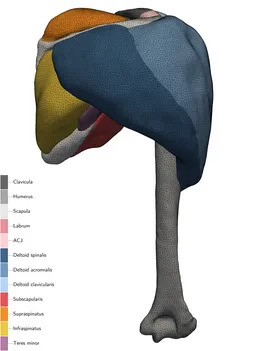Continuum-Mechanical Modeling of the Human Shoulder

Laura Engelhardt, Renate Sachse
The human shoulder is one of the functionally and anatomically most complex articular systems in the human body. Movement in the five associated joints is guided by a sophisticated interaction of bony components, tendinous and ligamentous stabilizers together with active muscle contractions. Muscles provide stability to the otherwise unstable glenohumeral articulation while simultaneously accounting for a wide range of motion of the arm. Due to this complex organization, the shoulder’s injury potential is high and pathological findings are common in clinical practice.
However, knowledge about the individual and integrated biomechanical function of the shoulder components remains limited and medical assessment can be challenging.
Aiming for an advanced understanding of human shoulder biomechanics in order to improve diagnosis and treatment, we are currently working on a three-dimensional continuum-mechanical finite element model of a healthy human shoulder serving as a baseline for the development of patient-specific models in the future.
Geometry generation from medical image data, active muscle material modeling, material parameter identification, simulation of contact between the involved components are just some of the aspects included in the computational modeling of the shoulder.